Oxygen Sensors for Industrial Application
Main Article Content
Abstract
The present work aimed to study a family of solid ceramic electrolytes based on magnesium oxide doped zirconium oxide, usually identified as Mg-PSZ (zirconia partially stabilized with magnesia), used in the manufacture of oxygen sensors for molten metals. A set of electrolytes was prepared by mechanical (milling) and thermal (sintering) processing, varying the composition in magnesia and the cooling rate from the sintering temperature. These two parameters are essential in terms of phase composition and microstructure of Mg-PSZ, determining the behavior of these materials. The structural and microstructural characterization was done by means of X-ray diffraction (XRD). The electrical properties were analyzed by impedance spectroscopy in air. In general, the results obtained from various concentrations of dopant, different cooling rates and the same sintering step condition showed an increased conductivity for samples with predominance of high temperature stable phases (tetragonal and cubic).
Downloads
Article Details

This work is licensed under a Creative Commons Attribution 4.0 International License.
Authors who publish with this journal agree to the following terms:
- Authors retain copyright and grant the journal right of first publication with the work simultaneously licensed under a Creative Commons Attribution License that allows others to share the work with an acknowledgement of the work's authorship and initial publication in this journal.
- Authors grant the journal the rights to provide the article in all forms and media so the article can be used on the latest technology even after publication and ensure its long-term preservation.
- Authors are able to enter into separate, additional contractual arrangements for the non-exclusive distribution of the journal's published version of the work (e.g., post it to an institutional repository or publish it in a book), with an acknowledgement of its initial publication in this journal.
- Authors are permitted and encouraged to post their work online (e.g., in institutional repositories or on their website) prior to and during the submission process, as it can lead to productive exchanges, as well as earlier and greater citation of published work (See The Effect of Open Access).

